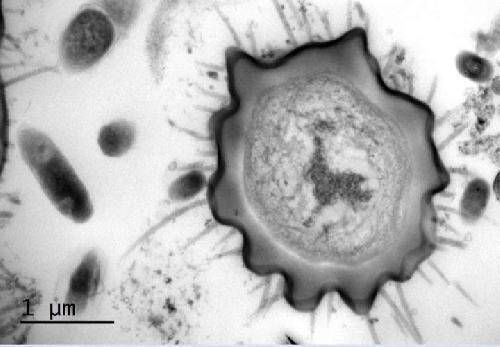The immature stage of the drone fly (Eristalis tenax) is known as a "rat-tailed maggot" because it resembles a hairless baby rodent with a "tail" that is actually used as a breathing tube. Rat-tailed maggots are known to live in stagnant, fetid water that is rich in bacteria, fungi, and algae. However, despite this dirty environment, they are able to avoid infection by these microorganisms.
Recently, Matthew Hayes, a cell biologist at the Institute of Ophthalmology at University College London in England, discovered never-before-seen structures that appear to keep the maggot mostly free of bacteria, despite living where microorganisms flourish. His findings appear in an article in the Journal of Insect Science.
With scanning and transmission electron microscopes, Hayes carefully examined the larva and saw that much of its body is covered with thin spines, or "nanopillars," that narrow to sharp points. Once he confirmed the spiky structures were indeed part of the maggot, he noticed a direct relationship between the presence of the spines and the absence of bacteria on the surface of the larva. He speculated that the carpet of spines simply makes it impossible for the bacteria to find enough room to adhere to the larva's body surface.
 This electron-microscope image expose the spines, or "nanopillars," that poke up from the body of the rat-tailed maggot. The length and density of the spines vary as shown in this cross-section image of the cuticle. Credit: Matthew Hayes
This electron-microscope image expose the spines, or "nanopillars," that poke up from the body of the rat-tailed maggot. The length and density of the spines vary as shown in this cross-section image of the cuticle. Credit: Matthew Hayes
"They're much like anti-pigeon spikes that keep the birds away because they can't find a nice surface to land on," he said.
Hayes also ventured that the spines could possibly have superoleophobic properties (the ability to repel oils), which would also impede the bacteria from colonizing and forming a biofilm that could ultimately harm or kill the maggot. The composition of the spines is as unique as the structures themselves, Hayes said. Each spine appears to consist of a stack of hollow-cored disks, the largest at the bottom and the smallest at the top.
"What I really think they look like is the baby's toy with the stack of rings of decreasing size, but on a very small scale," he said. "I've worked in many different fields and looked at lots of different things, and I've never seen anything that looks like it."
This work with the rat-tailed maggot is leading him to examine other insects as well, including the ability of another aquatic invertebrate -- the mosquito larva -- to thwart bacteria. Such antibacterial properties have applications in many different fields, including ophthalmology and other medical fields where biofilms can foul surgical instruments or implanted devices.
For now, though, he's thrilled about shedding light on the underappreciated rat-tailed maggot and revealing its spiny armor.
"I've loved insects since I was a child, when I would breed butterflies and moths," he said. "I'm just so chuffed to have discovered something a bit new about insects!"
source: Entomological Society of America